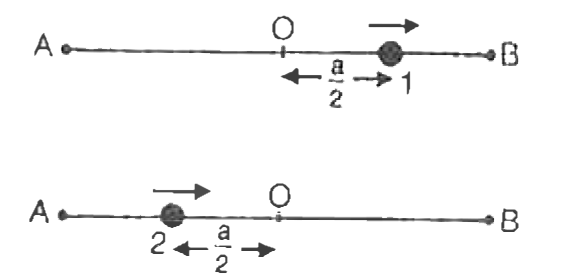Two bodies performing S.H.M. have same amplitude and frequency. Their phases at a certain instant are as shown in the figure. The phase difference between them is
_E01_002_Q01.png) Solution in Gujrati
Solution in Gujrati
(a)116π
(b)π
(c)53π
(d)35π
The correct Answer is:C
_E01_002_S01.png)
cosθ=A/2A=12⇒θ=π3
Total ohase difference between them
ϕ=2θ+π=5π3
Topper's Solved these Questions
- SIMPLE HARMONIC MOTIONBOOK - ALLEN CHAPTER - SIMPLE HARMONIC MOTIONEXERCISE - Exercise-02
19 Videos
- SIMPLE HARMONIC MOTIONBOOK - ALLEN CHAPTER - SIMPLE HARMONIC MOTIONEXERCISE - Exercise- 3 Match The Column
1 Videos
- SIMPLE HARMONIC MOTIONBOOK - ALLEN CHAPTER - SIMPLE HARMONIC MOTIONEXERCISE - SOME WORKED OUT EXAMPLES
29 Videos
- RACEBOOK - ALLEN CHAPTER - RACEEXERCISE - Basic Maths (Wave Motion & Dopplers Effect) (Stationary waves & doppler effect, beats)
25 Videos
- TEST PAPERBOOK - ALLEN CHAPTER - TEST PAPEREXERCISE - PHYSICS
4 Videos
Similar Questions
A mass M is performing linear simple harmonic motion. Then correct graph for acceleration a and corresponding linear velocity v is
View SolutionColumn-I gives different situtions in which bodes are floating in liquid. Column-II gives correspoding time periods of oscillation.
_E01_069_Q01.png)
A cube floating in liquid.
View SolutionA simple pendulum has time period 2s. The point of suspension is now moved upward accoding to relation y=(6t−3.75t2)m where t is in second and y is the vertical displacement in upward direction. The new time period of simple pendulum will be
View SolutionThe frequency of a radar is 780 MHz. After getting reflected from an approaching aeroplane, the apparent frequency is more than the actual frequency by 2.6 kHz. The aeroplane has a speed of
View SolutionChoose the correct statement:
View SolutionPhase difference between two waves having same frequency (v) and same amplitude (A) is 2π/3. If these waves superimpose each other, then resultant amplitude will be–
View SolutionFind the phase different between two particles executing simple harmonic motion with the same amplitude and frequency when their phases at a certain moment are as shown in the figure.

View SolutionThe phase difference between displacement and acceleration of a particle performing S.H.M. is
View SolutionTwo particles execute SHM of same amplitude and same time period, about same mean position but with a phase difference between them. At an instant they are found to cross each other at x=+A3. The phase difference between them is
View SolutionTwo particles P and Q performs S.H.M. of same amplitude 'A' and frequency n along the same straight line the resultant S.H.M. have the amplitude sqrt(2) times amplitude of individual. The initial phase difference between two particles will be nearly.
View SolutionIf the two particles performing S.H.M. with same amplitude and initial phase angle, then the initial phase angle of resultant motion depends on
View SolutionIf the two particles performing S.H.M. with different initial phase angle and amplitude, then the initial phase angle of resultant motion depends on
View SolutionIf the two particles performs S.H.M. of same initial phase angle but different amplitudes of individuals, then the resultant motion initial phase angle depends on
View SolutionThe two particles performing S.H.M. have a phase difference of π. If the amplitude of second particle is three times the amplitude of first particle, then the amplitude of resultant motion will be
View SolutionThe phase difference between displacement and acceleration of a particle performing S.H.M. is
View SolutionThe resultant of two S.H.M. having the same period T but different amplitudes and phases, along the same line is S.H.M
View Solution
